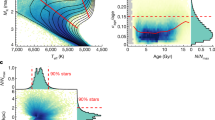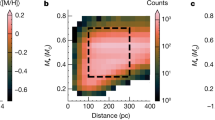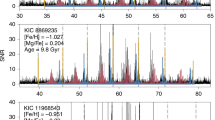Abstract
The chemical compositions of stars encode those of the gas from which they formed, providing important clues regarding the formation histories of galaxies. A powerful diagnostic is the abundance of α elements (O, Mg, Si, S, Ca and Ti) relative to iron, [α/Fe]. The α elements are synthesized and injected into the interstellar medium by type II supernovae, which occur about ten million years after their originating stars form; by contrast, iron is returned to the interstellar medium by type Ia supernovae, which occur after a much longer timescale of roughly one billion years1. Periods of rapid star formation therefore tend to produce high-[α/Fe] stellar populations (because only type II supernovae have time to contribute to interstellar-medium enrichment as the stellar population forms), whereas low-[α/Fe] stars require periods of star formation that last more than a few billion years (over which timescales type Ia supernovae begin to affect the elemental composition of the interstellar medium more strongly than type II supernovae). The existence of two distinct groups of stars in the solar neighbourhood2,3,4,5,6,7, one with high [α/Fe] and the other with low [α/Fe], therefore suggests two different origins, but the mechanism by which this bimodal distribution arose remains unknown. Here we use a model of disk-galaxy evolution to show that the two episodes of star formation8 predicted by the ‘cold flow’ theory of galactic gas accretion9,10 also explain the observed chemical bimodality. In this scenario, the high-[α/Fe] stars form early, during an initial phase of accretion that involves infalling streams of cold primordial gas. There is then a hiatus of around two billion years until the shock-heated gas in the galactic dark-matter halo has cooled as a result of radiation and can itself commence accretion. The low-[α/Fe] stars form during this second phase. The peaks in these two star-formation episodes are separated by around five billion years. In addition, the large-scale variation in the abundance patterns of these two stellar populations that has been observed for the Milky Way5,7 is partially explained by the spatial variation in this gas-accretion history.
This is a preview of subscription content, access via your institution
Access options
Access Nature and 54 other Nature Portfolio journals
Get Nature+, our best-value online-access subscription
$29.99 / 30 days
cancel any time
Subscribe to this journal
Receive 51 print issues and online access
$199.00 per year
only $3.90 per issue
Buy this article
- Purchase on Springer Link
- Instant access to full article PDF
Prices may be subject to local taxes which are calculated during checkout



Similar content being viewed by others
References
Matteucci, F. & Greggio, L. Relative roles of type I and II supernovae in the chemical enrichment of the interstellar gas. Astron. Astrophys. 154, 279–287 (1986).
Gratton, R., Carretta, E., Matteucci, F. & Sneden, C. The [Fe/O] ratio in field stars and the history of star formation of the solar neighbourhood. ASP Conf. Ser. 92, 307–316 (1996).
Adibekyan, V. Zh. et al. Chemical abundances of 1111 FGK stars from the HARPS GTO planet search program: galactic stellar populations and planets. Astron. Astrophys. 545, A32 (2012).
Haywood, M. et al. When the Milky Way turned off the lights: APOGEE provides evidence of star formation quenching in our Galaxy. Astron. Astrophys. 589, A66 (2016).
Anders, F. et al. Chemodynamics of the Milky Way I. The first year of APOGEE data. Astron. Astrophys. 564, A115 (2014).
Bensby, T., Feltzing, S. & Oey, M. S. Exploring the Milky Way stellar disk: a detailed elemental abundance study of 714 F and G dwarf stars in the solar neighbourhood. Astron. Astrophys. 562, A71 (2014).
Hayden, M. R. et al. Chemical cartography with APOGEE: metallicity distribution functions and the chemical structure of the Milky Way disk. Astrophys. J. 808, 132 (2015).
Birnboim, Y., Dekel, A. & Neistein, E. Bursting and quenching in massive galaxies without major mergers or AGNs. Mon. Not. R. Astron. Soc. 380, 339–352 (2007).
Fardal, M. A. et al. Cooling radiation and the Lyα luminosity of forming galaxies. Astrophys. J. 562, 605–617 (2001).
Dekel, A. & Birnboim, Y. Galaxy bimodality due to cold flows and shock heating. Mon. Not. R. Astron. Soc. 368, 2–20 (2006).
Schönrich, R. & Binney, J. Chemical evolution with radial mixing. Mon. Not. R. Astron. Soc. 396, 203–222 (2009).
Chiappini, C., Matteucci, F. & Gratton, R. The chemical evolution of the Galaxy: the two-infall model. Astrophys. J. 477, 765–780 (1997).
Snaith, O. et al. Reconstructing the star formation history of the Milky Way disc(s) from chemical abundances. Astron. Astrophys. 578, A87 (2015).
Rees, M. J. & Ostriker, J. P. Cooling, dynamics and fragmentation of massive gas clouds: clues to the masses and radii of galaxies and clusters. Mon. Not. R. Astron. Soc. 179, 541–559 (1977).
Noguchi, M. Possible imprints of cold mode accretion on the present-day properties of disk galaxies. Astrophys. J. 853, 67 (2018).
Gilmore, G. et al. The Gaia-ESO public spectroscopic survey. Messenger 147, 25–31 (2012).
Majewski, S. R. et al. The Apache Point Observatory Galactic Evolution Experiment (APOGEE). Astron. J. 154, 94–139 (2017).
Mayor, M. et al. Setting new standards with HARPS. Messenger 114, 20–24 (2003).
Danovich, M., Dekel, A., Hahn, O., Ceverino, D. & Primack, J. Four phases of angular-momentum buildup in high-z galaxies: from cosmic-web streams through an extended ring to disc and bulge. Mon. Not. R. Astron. Soc. 449, 2087–2111 (2015).
Romano, D., Karakas, A. I., Tosi, M. & Matteucci, F. Quantifying the uncertainties of chemical evolution studies II. Stellar yields. Astron. Astrophys. 522, A32 (2010).
Wyse, R. F. G. & Silk, J. Star formation rates and abundance gradients in disk galaxies. Astrophys. J. 339, 700–711 (1989).
Rojas-Arriagada, A. et al. The Gaia-ESO Survey: exploring the complex nature and origins of the Galactic bulge populations. Astron. Astrophys. 601, A140 (2017).
Haywood, M., Di Matteo, P., Lehnert, M. D., Katz, D. & Gómez, A. The age structure of stellar populations in the solar vicinity: clues of a two-phase formation history of the Milky Way disk. Astron. Astrophys. 560, A109 (2013).
Kobayashi, C. & Nakasato, N. Chemodynamical simulations of the Milky Way galaxy. Astrophys. J. 729, 16 (2011).
Williams, B. F. et al. PHAT XIX. The ancient star formation history of the M31 disk. Astrophys. J. 846, 145 (2017).
Williams, B. F., Dalcanton, J. J., Dolphin, A. E., Holtzman, J. & Sarajedini, A. The detection of inside-out disk growth in M33. Astrophys. J. 695, L15–L19 (2009).
Gogarten, S. M. et al. The Advanced Camera for Surveys Nearby Galaxy Survey Treasury. V. Radial star formation history of NGC 300. Astrophys. J. 712, 858–874 (2010).
Grand, R. J. J. et al. Origin of chemically distinct discs in the Auriga cosmological simulations. Mon. Not. R. Astron. Soc. 474, 3629–3639 (2018).
Cattaneo, A., Dekel, A., Devriendt, J., Guiderdoni, B. & Blaizot, J. Modelling the galaxy bimodality: shutdown above a critical halo mass. Mon. Not. R. Astron. Soc. 370, 1651–1665 (2006).
Dekel, A. et al. Cold streams in early massive hot haloes as the main mode of galaxy formation. Nature 457, 451–454 (2009).
Wechsler, R. H., Bullock, J. S., Primack, J. R., Kravtsov, A. V. & Dekel, A. Concentrations of dark halos from their assembly histories. Astrophys. J. 568, 52–70 (2002).
Bullock, J. S. et al. Profiles of dark haloes: evolution, scatter and environment. Mon. Not. R. Astron. Soc. 321, 559–575 (2001).
Ferreras, I. & Silk, J. Type Ia supernovae and the formation history of early-type galaxies. Mon. Not. R. Astron. Soc. 336, 1181–1187 (2002).
Maoz, D., Sharon, K. & Gal-Yam, A. The supernova delay time distribution in galaxy clusters and implications for type-Ia progenitors and metal enrichment. Astrophys. J. 722, 1879–1894 (2010).
Claeys, J. S. W., Pols, O. R., Izzard, R. G., Vink, J. & Verbunt, F. W. M. Theoretical uncertainties of the type Ia supernova rate. Astron. Astrophys. 563, A83 (2014).
Smith, M. C. et al. The RAVE survey: constraining the local Galactic escape speed. Mon. Not. R. Astron. Soc. 379, 755–772 (2007).
Bovy, J. & Rix, H.-W. A direct dynamical measurement of the Milky Way’s disk surface density profile, disk scale length, and dark matter profile at 4 kpc < r < 9 kpc. Astrophys. J. 779, 115 (2013).
Licquia, T. C. & Newman, J. A. Improved estimates of the Milky Way’s stellar mass and star formation rate from hierarchical Bayesian meta-analysis. Astrophys. J. 806, 96 (2015).
Asplund, M., Grevesse, N., Sauval, A. J. & Scott, P. The chemical composition of the Sun. Annu. Rev. Astron. Astrophys. 47, 481–522 (2009).
Acknowledgements
We acknowledge I. Ferreras for comments.
Reviewer information
Nature thanks G. Cescutti, A. Dekel and the other anonymous reviewer(s) for their contribution to the peer review of this work.
Author information
Authors and Affiliations
Corresponding author
Ethics declarations
Competing interests
The author declares no competing interests.
Additional information
Publisher’s note: Springer Nature remains neutral with regard to jurisdictional claims in published maps and institutional affiliations.
Rights and permissions
About this article
Cite this article
Noguchi, M. The formation of solar-neighbourhood stars in two generations separated by 5 billion years. Nature 559, 585–588 (2018). https://doi.org/10.1038/s41586-018-0329-2
Received:
Accepted:
Published:
Issue Date:
DOI: https://doi.org/10.1038/s41586-018-0329-2
This article is cited by
-
Modelling the chemical evolution of the Milky Way
The Astronomy and Astrophysics Review (2021)
-
Meta-analysis from different tracers of the small Local Arm around the Sun—extent, shape, pitch, origin
Astrophysics and Space Science (2018)
Comments
By submitting a comment you agree to abide by our Terms and Community Guidelines. If you find something abusive or that does not comply with our terms or guidelines please flag it as inappropriate.



